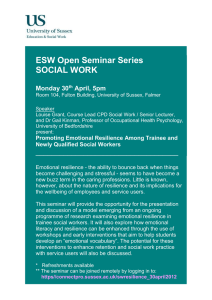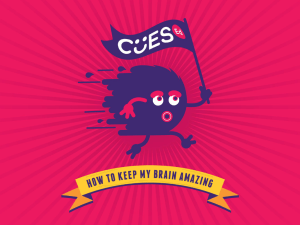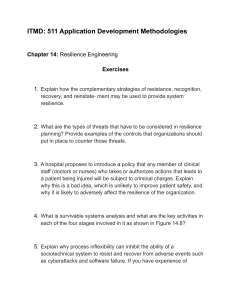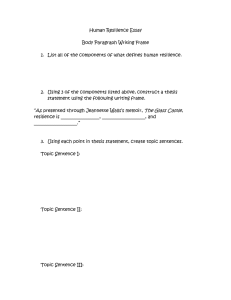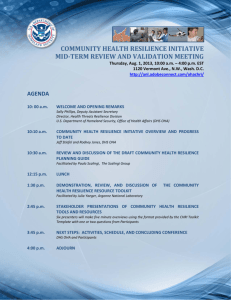Improving Practice and Policy - European Network for Mental Health
advertisement
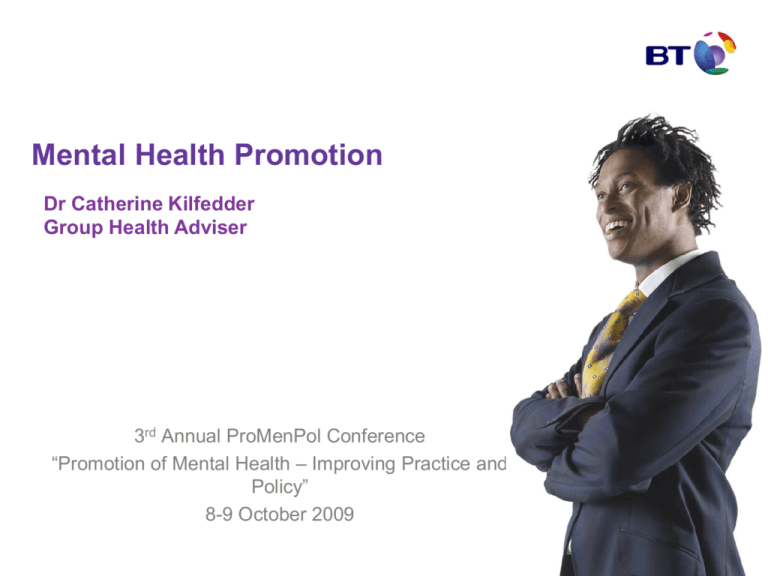
Mental Health Promotion Dr Catherine Kilfedder Group Health Adviser 3rd Annual ProMenPol Conference “Promotion of Mental Health – Improving Practice and Policy” 8-9 October 2009 BT - a global business North America c3,900 employees Russia / CEE c400 employees UK c84,000 employees Western Europe c9,700 employees Asia Pac c4,400 Latin America c700 employees MEA c200 employees BT Divisions BT Retail * BT Wholesale BT Global Services * BT Operate * BT Innovate and Design* Openreach * Global operations c103,300 BT people Why address mental health and wellbeing? Already facing… • Increasing globalisation • Organisational change and restructuring • New technologies • Changing workforce demographics • Changing general population health risk profile And now … • Threats of unemployment and financial strains leading to increasing levels of stress • Reductions in exercise and healthy eating • Morbidity and mortality rise in hard times • Presenteeism increases BT People Strategy – Theme 5 Creating a healthy and diverse environment where excellence prospers Work Fit – Positive Mentality • A rolling health promotion programme. • To improve the well being of BT people, and encourage them to take personal responsibility for their own health. • Promoting good health, preventing ill health, minimising risk, early identification, support. Positive Mentality campaign aims • • • • • • Company culture, values and inclusivity. Educate on the basis of evidence – dispel myths. Concentrate on common mental health problems. Provide practical tools for people and managers. Keep mental health mainstream – beware “experts”. Address stigma through multi-channel communications. • Maintain a business focus at all times. • Raise awareness, tackle stigma, promote mental well-being. • 16 week campaign • 8 modules & roadshows • Based on 10 positive steps from World MH Day • Partners – CWU, Connect – SCMH, MIND Behavioural changes to increase resilience and promote wellbeing 1. Keep active 2. Eat well / drink sensibly 3. Relax 4. Keep in touch 5. Talk about it 6. Maintain relationships 7. Ask for help 8. Accept who you are Positive thinking Impact • 68% learned something new about ways to look after their MH. • 56% tried some of the recommendations and were continuing to practice them at the time of the followup. • Of those who had made changes, 51% had noticed improvements in their mental well-being. • 39% had gone on to look at other BT MH materials. Success factors • Focus on specific health and wellbeing factors. • A rolling programme to build and maintain momentum. • Work with strategic and expert partners. • In partnership with trade unions. • Engage with the audiences using innovative communication and marketing methods. • Exploit technology to increase reach and costeffectiveness. • Practical and easy to use advice and tools. • Measure the results. Preventative The workplace The job Training BT PEOPLE Leadership Education Management Protective Maximise support Action plan Identify & address early Build resilience Enhance coping Restorative Rehab CBT “OHS” Tel, F2F CCBT Couns. Guided Self-help MH 1st Aid HR LM Stay at Work Get back to Work Move on with dignity Recommendations for practice and policy • • • • Understand the target audience Multiple delivery strategies for ‘hard to reach’ groups Local championing and implementation Sustainable, part of a coherent H&WB strategy • Focus on prevention • Actively promote resilience • Disseminate the evidence and business case • Cannot overemphasise the role of managers Investing in workplace mental health can: • Help to improve employee engagement and motivation. • Improve employees’ emotional resilience and their ability to cope with stress. • Improve employee productivity. • Help ensure the organisation is fitter for purpose and better placed to weather changing economic conditions over the long-term. • Help the organisation position itself for the eventual upturn in the economy. © British Telecommunications plc




